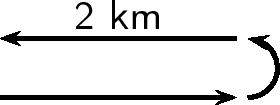| << Chapter < Page | Chapter >> Page > |
Velocity is the rate of change of displacement.
Instantaneous velocity is the velocity of a body at a specific instant in time.
Average velocity is the total displacement of a body over a time interval.
Velocity is the rate of change of position. It tells us how much an object's position changes in time. This is the same as the displacement divided by the time taken. Since displacement is a vector and time taken is a scalar, velocity is also a vector. We use the symbol for velocity. If we have a displacement of and a time taken of , is then defined as:
Velocity can be positive or negative. Positive values of velocity mean that the object is moving away from the reference point or origin and negative values mean that the object is moving towards the reference point or origin.
Average velocity (symbol ) is the displacement for the whole motion divided by the time taken for the whole motion. Instantaneous velocity is the velocity at a specific instant in time.
This is terminology that occurs quite often and it is important to always remember that instantaneous and average quantities are not always the same. In fact, they can be very different. The magnitude of the instantaneous velocity is the same as the slope of the line which is a tangent to the displacement curve at the time of measurement. The magnitude of the average velocity is the same as the slope of the line between the start and end points of the interval.
If you want to think about why the tangent at a particular time gives us the velocity remember that the velocity is the slope of the displacement curve. Now, a simple why to start thinking about it is to image you could zoom (magnify) the displacement curve at the point. The more you zoom in the more it will look like a straight line at the point and that straight line will be very similar to the tangent line at the point. This isn't a mathematical proof but you will learn one later on in mathematics about limits and slopes.
(Average) Speed (symbol ) is the distance travelled ( ) divided by the time taken ( ) for the journey. Distance and time are scalars and therefore speed will also be a scalar. Speed is calculated as follows:
Instantaneous speed is the magnitude of instantaneous velocity. It has the same value, but no direction.
James walks 2 km away from home in 30 minutes. He then turns around and walks back home along the same path, also in 30 minutes. Calculate James' average speed and average velocity.

The question explicitly gives
The information is not in SI units and must therefore be converted.
To convert km to m, we know that:
Similarly, to convert 30 minutes to seconds,
James started at home and returned home, so his displacement is 0 m.
James walked a total distance of 4 000 m (2 000 m out and 2 000 m back).
James took 1 800 s to walk out and 1 800 s to walk back.

Notification Switch
Would you like to follow the 'Siyavula textbooks: grade 10 physical science [caps]' conversation and receive update notifications?